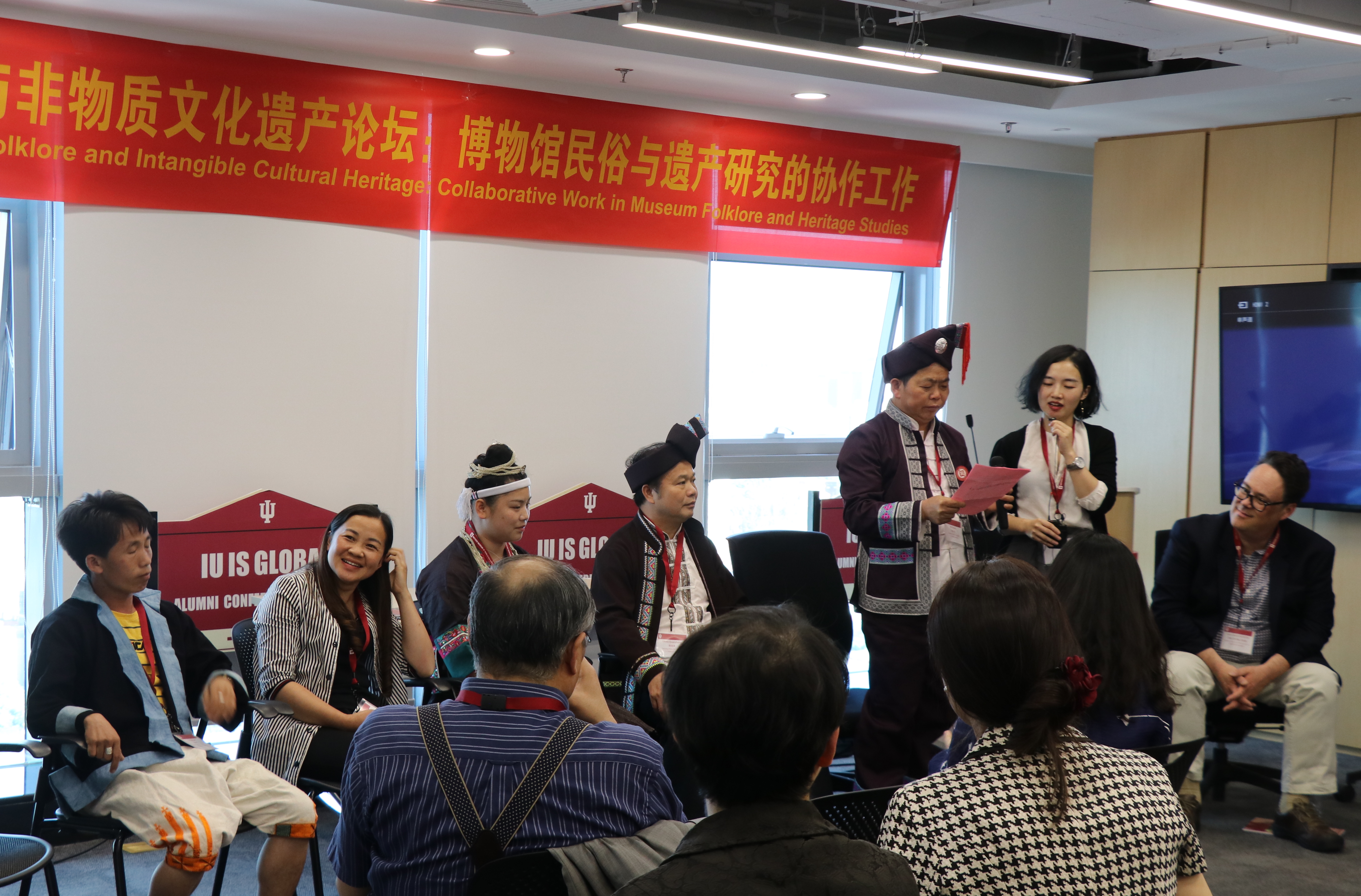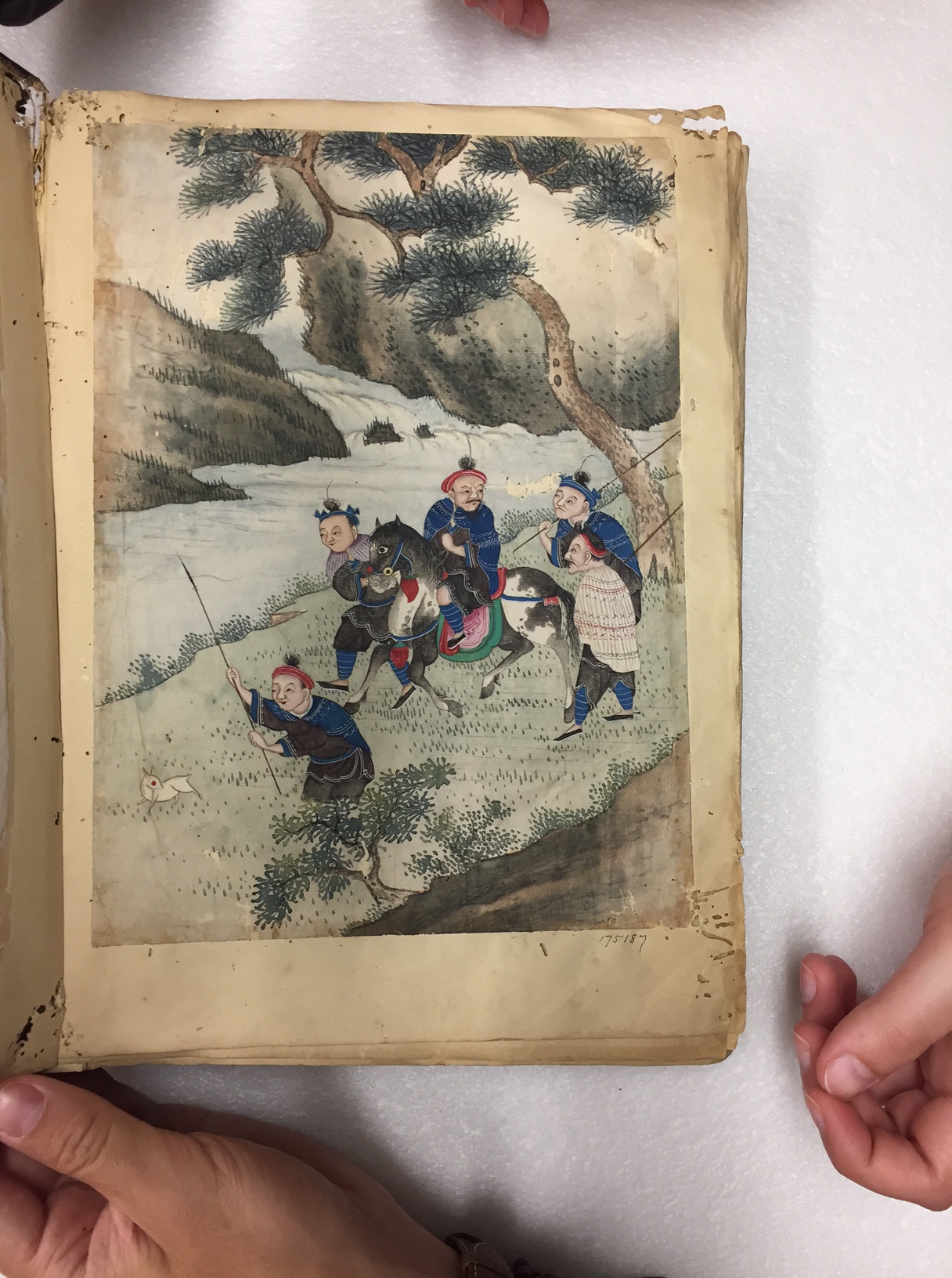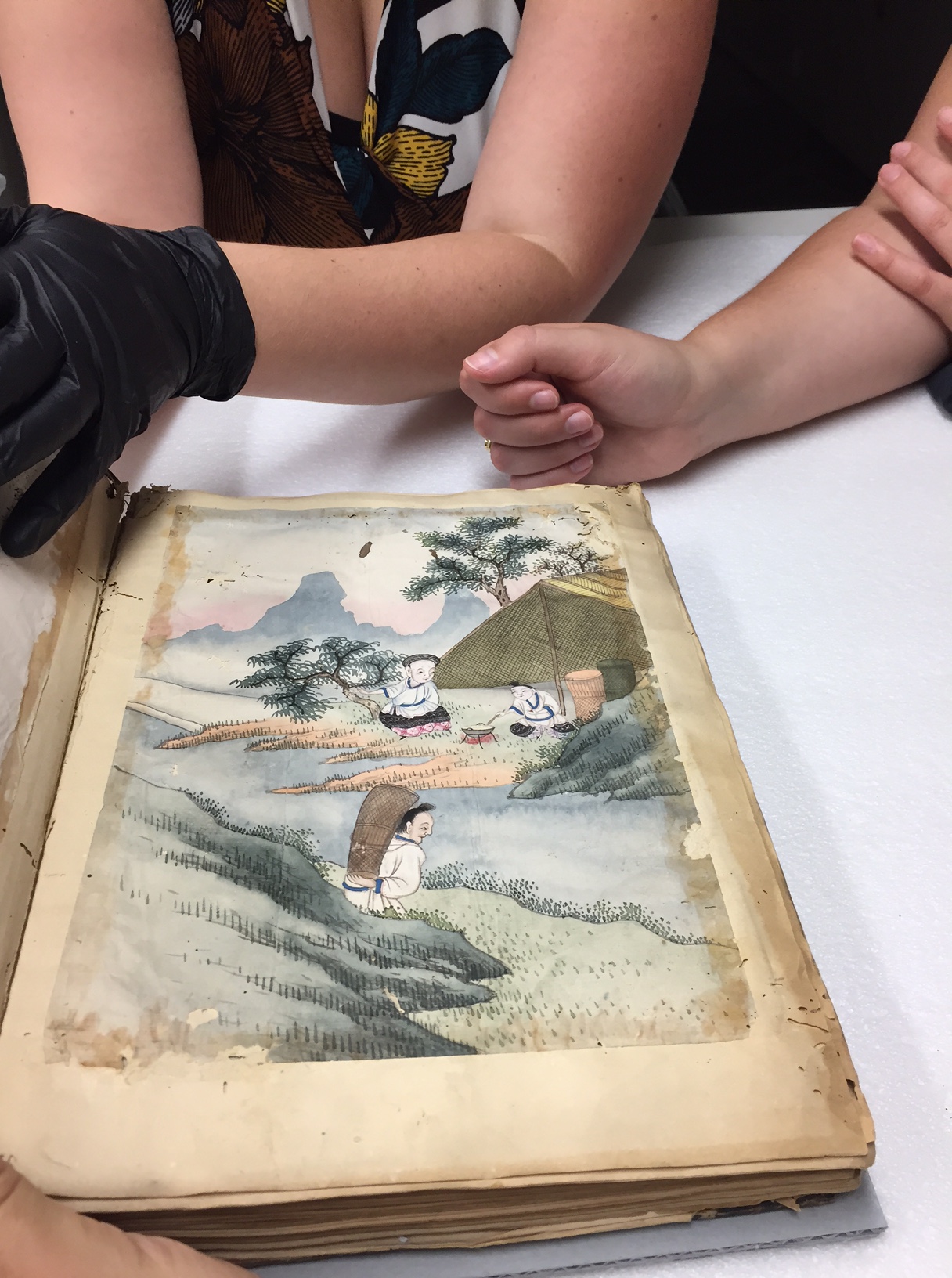The following is a report on The Seventh Forum on China-US Folklore and Intangible Cultural Heritage: Collaborative Work in Museum Folklore and Heritage Studies (第七届中美民俗学与非物质文化遗产论坛: 博物馆民俗与遗产研究的协作工作). The version of record appears on the website of the American Folklore Society. This version adds more images. You can find a copy of the conference program here. –Jason Baird Jackson (杰森. 拜尔德. 杰克逊)
During three beautiful spring days in Beijing, a group of Chinese and American scholars and cultural workers gathered to discuss practices of collaboration in folklore studies and intangible cultural heritage work, with a focus on collaborations between ethnographic museums and between such museums and other groups in society. Held on May 19-22, 2019, this was the Seventh Forum on China-US Folklore and Intangible Cultural Heritage, one of a long-running series of conferences organized cooperatively by the China Folklore Society (CFS) and the American Folklore Society (AFS), as part of a broader binational collaboration begun in 2007. These forums have explored various aspects of cultural heritage policy, practice, and theory, giving US and Chinese participants an opportunity to learn about the state of the field as pursued in the national context that is not their own (Lloyd 2017).
This Seventh Forum, focusing on Collaborative Work in Museum Folklore and Heritage Studies, was held at the Indiana University China Gateway office in Beijing. Meeting under the auspices of the CFS and the AFS, the conference’s program was organized by the Mathers Museum of World Cultures and the Anthropology Museum of Guangxi (Guangxi Museum of Nationalities), with extensive logistical and practical support provided by the two societies and the gateway office staff. Generous financial support was provided by the Henry Luce Foundation and the Office of the Vice President for International Affairs at Indiana University.
Delegates to the forum came from a diversity of American and Chinese museums and universities. Chinese institutions represented included the Chinese Academy of Social Sciences, Sun Yat-sen University, the Anthropology Museum of Guangxi, the Nandan Baiku Yao Ecomuseum, Beijing Normal University, the Sanjiang Dong Ecomuseum, East China Normal University, Fudan University, the Guizhou Nationalities Museum, Minzu University of China, Shandong University, and the Yunnan Nationalities Museum. American institutions represented included the Michigan State University Museum, the Museum of International Folk Art, Texas Tech University, the Mathers Museum of World Cultures (Indiana University), History Miami, the Sam Noble Oklahoma Museum of Natural History (University of Oklahoma), and the American Folklore Society (Figure 1).

Figure 1. Delegates to the Seventh Forum on China-US Folklore and Intangible Cultural Heritage held at the Indiana University Gateway Office in Beijing, May 19, 2019. Shu Caiqian (Guizhou Nationalities Museum), Zhang Yibing (Guizhou Nationalities Museum, Zhu Gang (Chinese Academy of Social Sciences), Li Mingjie (East China Normal University), Wang Wei (Shandong University), Jessica Anderson Turner (American Folklore Society), An Deming (Chinese Academy of Social Sciences), Luo Wenhong (Fudan University), Marsha MacDowell (Michigan State University Museum), Surna (Minzu University of China), Kristin Otto (Mathers Museum of World Cultures), Felicia Katz-Harris (Museum of International Folk Art), Sarah Hatcher (Mathers Museum of World Cultures), Yang Lihui (Beijing Normal University), Lu Chaoming (Nandan Baiku Yao Ecomuseum), Jason Baird Jackson (Mathers Museum of World Cultures), Chen Xi (Sun Yet-sen University), Carrie Hertz (Museum of International Folk Art), Chao Gejin (Chinese Academy of Social Sciences), Wuerxiya (Mathers Museum of World Cultures), Fan Miaomiao (Anthropology Museum of Guangxi), C. Kurt Dewhurst (Michigan State University Museum), Yang Quanzhong (Sanjang Dong Ecomuseum), He Chun (Nandan Baiku Yao Ecomuseum), Michael Paul Jordan (Texas Tech University), Wu Dawei (Sanjang Dong Ecomuseum), Ou Bo (Anthropology Museum of Guangxi), Michael Knoll (History Miami), Lan Yuanyuan (Sanjang Dong Ecomuseum), Gong Shiyang (Anthropology Museum of Guangxi), Jon Kay (Mathers Museum of World Cultures), Luo Yong (Nandan Baiku Yao Ecomuseum), Mai Xi (Anthropology Museum of Guangxi), Zhao Fei (Yunnan Nationalities Museum), Wang Yucheng (Anthropology Museum of Guangxi).
On the afternoon of May 19, the conference began with warm words of welcome from AFS Executive Director Jessica Turner and CFS Past President Chao Gajin (Chinese Academy of Social Sciences), standing in for current CFS President Ye Tao (Chinese Academy of Social Sciences) who was unable to attend (Figure 2). Also offering brief opening remarks on behalf of the program committee were Jason Baird Jackson (Mathers Museum of World Cultures) and Gong Shiyang (Anthropology Museum of Guangxi) (Figure 3). These remarks preceded the forum’s keynote address by C. Kurt Dewhurst (Michigan State University Museum). Extending an earlier discussion of principles for museum collaboration (Dewhurt and MacDowell 2015), Dewhurt reflected on a range of museum collaborations in which he and the MSU Museum have participated. Among the collaborations that Dewhurst addressed were earlier phases of the AFS-CFS partnership, which has included two museum sub-projects (2013-2016; 2017-2019). The first of these encompassed the Fifth and Sixth forum events, the traveling exhibition and bilingual catalogue Quilts of Southwest China (MacDowell and Zhang 2015), and numerous other elements (Lloyd 2017). In this phase, three Chinese museums and three US museums partnered together (Dewhurst and Lloyd 2019). In the more recent phase, collaborators from the three U.S. museums have joined with the Anthropology Museum of Guangxi for a program of joint research focused on textiles and intangible cultural heritage policy in two northern counties of the Guangxi Zhuang Autonomous Region. Central to this new phase of work are the Nandan Baiku Yao Ecomuseum and the Sanjiang Dong Ecomuseum. Thus, while Dewhurst’s keynote was a general reflection on museum collaboration, his presentation also served to orient conferees to the specific joint AFS-CFS supported projects that gave the forum its organizational context.
The keynote address was followed by a panel discussion in which representatives from the Sanjiang Dong Ecomuseum and Nandan Baiku Yao Ecomuseum described their work and the community and organizational collaborations in which they participate (Figure 4). American participants appreciated this opportunity to learn about the innovative work of these ecomuseums first-hand and drew comparisons to various kind of community-based museums in the US. While Chinese delegates were more knowledgeable about the form that ecomuseums take in China, they also appreciated the chance to engage with the ecomuseum leaders directly in a comparative scholarly context.
It was an honor that many Beijing-based leaders in the CFS and in Chinese folklore studies overall could attend these opening events, which also included a welcoming banquet generously hosted by the CFS. This gathering was enlivened further when the leaders of the Sanjiang Dong Ecomuseum introduced both Dong flute music and toasting songs to the group. For many American delegates, this was a memorable first experience with the richness of Chinese banquet customs and the beauty of Dong music (Figure 5).
The second day of the conference was a full day featuring presentations from Chinese and American delegates. In line with the goals of the forum, the presenters described specific museum collaboration projects, using them as the basis for broader reflections on the work of museum ethnography and heritage studies today. Translation for most conference presentations was very ably done by Chen Xi (Sun Yat-sen University) and Luo Wenhong (Fudan University) (Figure 6). A number of themes emerged through the juxtaposition of presentations throughout the conference. These included: (1) the nature of museum-based ethnographic and exhibition projects in urban contexts, (2) the dynamics unique to heritage-oriented fieldwork pursued across differences of language, culture, and institutional context, (3) the place of objects and material culture studies within museum collaborations, (4) the use of exhibitions as catalysts for broader collaborations and relationship building, (5) the value of older museum collections for contemporary communities and craftspeople, (6) the place of documentary video in museum ethnography, and (7) the special importance that attaches to national folk costume in diverse museum and local cultural contexts in the current era (Figure 7).
The conference’s third day featured a morning of additional presentations followed by a special outing in which conferees visited Beijing’s Shichahai historic area to learn about cultural preservation and heritage tourism activities centered there (Figures 8-9). Participants enjoyed a hutong tour and a visit to the Drum Towner of Beijing (Gulou). While she could not attend the forum, this outing was curated by Zhang Lijun (George Mason University) and drew upon her folklore research interpreting the narrative performances of hutong tour guides (Zhang 2016, 2019). The conference concluded with a banquet, hosted by AFS and featuring Yunnan cuisine. Highpoints of this concluding gathering were many individual expressions of friendship and goodwill as well as a vigorous singing competition staged between the binational groups gathered around two large banquet tables. Heartfelt singing in Dong, Yao, Mandarin, Mongolian and English brought the seventh forum to a joyful close.
References Cited
Dewhurst, C. Kurt, and Timothy Lloyd. 2019. “The American Folklore Society-China Folklore Society Folklore and Intangible Cultural Heritage Project, 2013-2016.” Museum Anthropology Review 13 (1): 59-68. https://doi.org/10.14434/mar.v13i1.25405
Dewhurst, C. Kurt, and Marsha MacDowell. 2015. “Strategies for Creating and Sustaining Museum-Based International Collaborative Partnerships.” Practicing Anthropology 37 (3): 54–55. https://doi.org/10.17730/0888-4552-37.3.54
Lloyd, Tim. 2017 “The Inside Story of the AFS China-US Project.” https://www.afsnet.org/news/349609/The-Inside-Story-of-the-AFS-China-US-Project.htm, accessed June 12, 2019.
MacDowell, Marsha, and Lijun Zhang, eds. 2016. 中国西南拼布 | Quilts of Southwest China. Nanning: Guangxi Museum of Nationalities. [Distributed in the United States by Indiana University Press.]
Zhang, Lijun. 2016. “Performing Locality and Identity: Rickshaw Driver, Narratives, and Tourism.” Cambridge Journal of China Studies 11 (1): 88-104. https://www.repository.cam.ac.uk/handle/1810/260292
Zhang, Lijun. 2019. “A Brief Guide to Shichahai.” Video Presentation Prepared for The Seventh Forum on China-US Folklore and Intangible Cultural Heritage: Collaborative Work in Museum Folklore and Heritage Studies, Beijing, China.

Figure 2. Figure 2. Chao Gajin welcomes delegates to the Seventh Forum on China-US Folklore and Intangible Cultural Heritage: Collaborative Work in Museum Folklore and Heritage Studies. May 19, 2019. Photograph by Jon Kay.

Figure 3. Figure 3. Gong Shiyang addresses delegates to the Seventh Forum on China-US Folklore and Intangible Cultural Heritage. May 19, 2019. Photograph by Jon Kay.

Figure 4. Wu Dawei offers remarks on the work of the Sanjang Dong Ecomuseum during the ecomuseum panel discussion. Left to Right: Lu Chaoming, He Chun, Lan Yuanyuan, Yang Quanzhong, Wu Dawei, Luo Wenhong (translating), Jason Baird Jackson. May 19, 2019. Photograph by Jon Kay.

Figure 5. Wu Dawei performs Dong flute music at the opening banquet. May 19, 2019. Photograph by C. Kurt Dewhurst.

Figure 6. Zhang Yibing discusses the work of the Guizhou Nationalities Museum with Luo Wenhong providing English translation.. May 20, 2019. Photograph by Jon Kay.

Figure 7. Carrie Hertz discusses research related to the exhibition Dressing with Purpose. May 20, 2019. Photograph by Jon Kay.

Figure 8. Surna discusses her research on Mongol national dress. May 21, 2019. Photograph by Jon Kay.

Figure 9. Lan Yuanyuan and He Chun begin a rickshaw tour of the Shichahai neighborhood in Beijing. May 21, 2019. Photography by Jason Baird Jackson.





























![FullSizeRender[3]](https://jasonbairdjackson.files.wordpress.com/2017/07/fullsizerender3.jpg)
 More baskets, of course.
More baskets, of course.





![FullSizeRender[4]](https://jasonbairdjackson.files.wordpress.com/2017/07/fullsizerender4.jpg)
![FullSizeRender[6]](https://jasonbairdjackson.files.wordpress.com/2017/07/fullsizerender6.jpg)

![FullSizeRender[8]](https://jasonbairdjackson.files.wordpress.com/2017/07/fullsizerender8.jpg)
![FullSizeRender[9]](https://jasonbairdjackson.files.wordpress.com/2017/07/fullsizerender9.jpg)
 The region’s famous basketry raincoats, we think.
The region’s famous basketry raincoats, we think.![FullSizeRender[10]](https://jasonbairdjackson.files.wordpress.com/2017/07/fullsizerender10.jpg)




